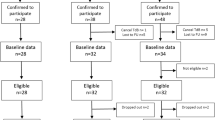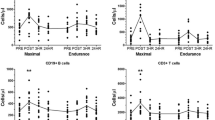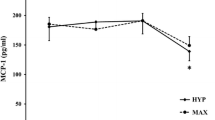Abstract
Purpose
The aim of this study is to investigate the effect of intensity and duration of exercise related to the leucocyte count.
Methods
25 male subjects completed all nine cycling sessions at 55 ± 5 rpm on a cycle ergometer for 10, 20, and 30 min at workloads that corresponded to 50, 60, and 70% of an individual’s pre-determined peak oxygen consumption (\(\dot {V}\)O2peak), in random order. Heart rate and \(\dot {V}\)O2peak were monitored each minute during the exercise to ensure that the subjects were exercising at the given relative intensity. Blood samples were taken before and after the exercise.
Results
The overall leucocyte counts and its subtypes including lymphocytes, monocytes, and neutrophils were significantly elevated immediately after exercise at all intensity and duration of exercise. ANOVA showed that the main effect of time (T) on leucocyte, neutrophil, lymphocyte, and monocyte counts increases over time. ANOVA analysis also showed that only exercise duration has a significant effect in overall leucocyte counts, including its subtypes. Additionally, this study also revealed that the overall leucocyte counts and its subtypes had a positive correlation with the duration of exercise using Pearson’s correlation coefficient test. However, only lymphocytes were positively correlated (r = 0.178) with exercise intensity.
Conclusions
This study strongly recommends a re-evaluation of current views about the intensity and duration of physical exercise. A precise definition of an individual’s workload that consists of intensity and duration of exercise is crucial as it will affect blood viscosity and blood flow during and immediately after exercise.


Similar content being viewed by others
References
Sand KL, Flatebo T, Andersen MB, Maghazachi AA (2013) Effects of exercise on leukocytosis and blood hemostasis in 800 healthy young females and males. World J Exp Med 3:11–20
Lowe GDO (1993) Blood viscosity and cardiovascular risk. Curr Opin Lipidol 4:283
Li J, Flammer AJ, Reriani MK, Matsuo Y, Gulati R, Friedman PA, Thomas RJ, Sandhu NP, Lerman LO, Lerman A (2013) High leukocyte count is associated with peripheral vascular dysfunction in individuals with low cardiovascular risk. Circulation J 77:780–785
Kim JH, Lim S, Park KS, Jang HC, Choi SH (2017) Total and differential WBC counts are related with coronary artery atherosclerosis and increase the risk for cardiovascular disease in Koreans. PLoS One 12:e0180332
Gabriel H, Kindermann W (1997) The acute immune response to exercise: what does it mean? Int J Sports Med 18:S28–S45
Abdossaleh Z, Fatemeh A, Frozan K, Mohhammad Amin S (2014) Leukocytes subsets is differentially affected by exercise intensity. Int J Sport Stud 4:246–253
Neves PRDS, Tenório TRDS, Lins TA, Muniz MTC, Pithon-Curi TC, Botero JP, Do Prado WL (2015) Acute effects of high- and low-intensity exercise bouts on leukocyte counts. J Exerc Sci Fit 13:24–28
McCarthy DA, Dale MM (1988) The leucocytosis of exercise. A review and model. Sports Med 6:333–363
van Eeden SF, Granton J, Hards JM, Moore B, Hogg JC (1999) Expression of the cell adhesion molecules on leukocytes that demarginate during acute maximal exercise. J Appl Physiol 86:970–976
Tuan TC, Hsu TG, Fong MC, Hsu CF, Tsai KK, Lee CY, Kong CW (2007) Deleterious effects of short-term, high-intensity exercise on the immune function: evidence from leukocyte mitochondrial alternations and apoptosis. Br J Sports Med 42:11–15
Pescatello LS, Arena R, Riebe D, Thompson PD (2014) ACSM’s guidelines for exercise testing and prescription, 9th edn. Lippincottt Williams & Wilkins, Philadelphia
Wasserman K, Hansen JE, Sietsema K, Sue DY, Stringer WW, Whipp B, Sun XG (2015) Principles of exercise testing and interpretation: including pathophysiology and clinical applications, 5th edn. Wolters Kluwer Health, Philadelphia
Dill DB, Costill DL (1974) Calculation of percentage changes in volumes of blood, plasma, and red cells in dehydration. J Appl Physiol 37:247–248
Perez CJ, Nemet D, Mills PJ, Scheet TP, Ziegler MG, Cooper DM (2001) Effects of laboratory versus field exercise on leukocyte subsets and cell adhesion molecule expression in children. Eur J Appl Physiol 86:34–39
Pedersen BK, Hoffman-Goetz L (2000) Exercise and the immune system: regulation, integration, and adaptation. Physiol Rev 80:1055–1081
Pyne DB (1994) Regulation of neutrophil function during exercise. Sports Med 17:245–258
Hack V, Strobel G, Rau JP, Weicker H (1992) The effect of maximal exercise on the activity of neutrophil granulocytes in highly trained athletes in a moderate training model. Eur J Appl Physiol Occup Physiol 65:520–524
Fehrenbach E, Schneider ME (2006) Trauma-induced systemic inflammatory response versus exercise-induced immunomodulatory effects. Sports Med 36:373–384
Foster NK, Martyn JB, Rangno RE, Hogg JC, Pardy RL (1986) Leukocytosis of exercise: role of cardiac output and catecholamines. J Appl Physiol 61:2218–2223
Hall JE (2016) Guyton and Hall textbook of medical physiology, 13th edn. Elsevier, Philadelphia
Fehrenbach E (2005) Cellular responses to environmental stress. In: Mooren FC, Volker K (eds) Molecular and cellular exercise physiology. Human Kinetic, Champaign, pp 199–217
Avloniti AA, Douda HT, Tokmakidis SP, Kortsaris AH, Papadopoulou EG, Spanoudakis EG (2007) Acute effects of soccer training on white blood cell count in elite female players. Int J Sports Physiol Perform 2:239–249
Cipryan L, Tschakert G, Hofmann P (2017) Acute and post-exercise physiological responses to high-intensity interval training in endurance and sprint athletes. J Sports Sci Med 16(2):219–229
Gabriel H, Brechtel L, Urhausen A, Kindermann W (1994) Recruitment and recirculation of leukocytes after an ultramarathon run: preferential homing of cells expressing high levels of the adhesion molecule LFA-1. Int J Sports Med 15:S148–S153
Nielsen HG, Lyberg T (2004) Long-distance running modulates the expression of leucocyte and endothelial adhesion molecules. Scand J Immunol 60(4):356–362
Žákovská A, Knechtle B, Chlíbková D, Miličková M, Rosemann T, Nikolaidis PT (2017) The effect of a 100-km ultra-marathon under freezing conditions on selected immunological and hematological parameters. Front Physiol 8:638
Hitosugi M, Kawato H, Nagai T, Ogawa Y, Niwa M, Iida N, Yufu T, Tokudome S (2004) Changes in blood viscosity with heavy and light exercise. Med Sci Law 44:197–200
Sloop GD (2017) Blood viscosity: its role in cardiovascular pathophysiology and hematology. Nova Science Publishers, New York
Morris JN, Clayton DG, Everitt MG, Semmence AM, Burgess EH (1990) Exercise in leisure time: coronary attack and death rates. Heart 63:325–334
Lowe GDO, Lee AJ, Rumley A, Price JF, Fowkes FGR (1997) Blood viscosity and risk of cardiovascular events: the Edinburgh Artery Study. Br J Haematol 96:168–173
Josephson ME (2014) Sudden cardiac arrest. Ind Heart J 66:S2–S3
Burgomaster KA, Howarth KR, Phillips SM, Rakobowchuk M, MacDonald MJ, McGee SL, Gibala MJ (2008) Similar metabolic adaptations during exercise after low volume sprint interval and traditional endurance training in humans. J Physiol 586:151–160
Guimarães GV, Ciolac EG, Carvalho VO, D’Avila VM, Bortolotto LA, Bocchi EA (2010) Effects of continuous vs. interval exercise training on blood pressure and arterial stiffness in treated hypertension. Hypertens Res 33:627–632
Acknowledgements
We would like to thank all the volunteers who participated in this study. This study was supported by the Universiti Kebangsaan Malaysia under the UKM Fundamental Research Grant Scheme (Grant No.: FF-050-2004) and the Ministry of Higher Education, Malaysia (Grant No.: TRGS0004-SG-12/2014).
Author information
Authors and Affiliations
Corresponding author
Ethics declarations
Conflict of interest
The authors declare that they have no conflicts of interest.
Ethical approval
The ethical approval of this study was obtained from the National Medical Research Register with reference no.: NMRR-16-38-28777(IIR) and Universiti Kebangsaan Malaysia Medical Research Ethics Committee, with reference no.: UKM 1.5.3.5/244/PPP2.
Informed consent
All participants provided written informed consent to participate in this study.
Rights and permissions
About this article
Cite this article
Ag. Daud, D.M., Mohammad Yusoff, A.S. & Wan Ngah, W. Elevation of leukocyte counts is associated with an increase in the intensity and duration of exercise. Sport Sci Health 15, 73–83 (2019). https://doi.org/10.1007/s11332-018-0486-6
Received:
Accepted:
Published:
Issue Date:
DOI: https://doi.org/10.1007/s11332-018-0486-6




